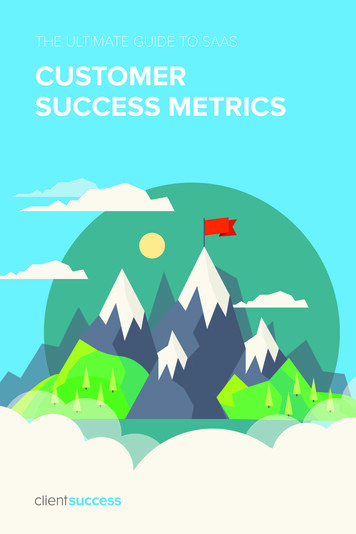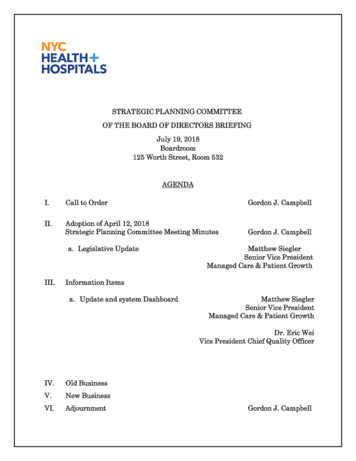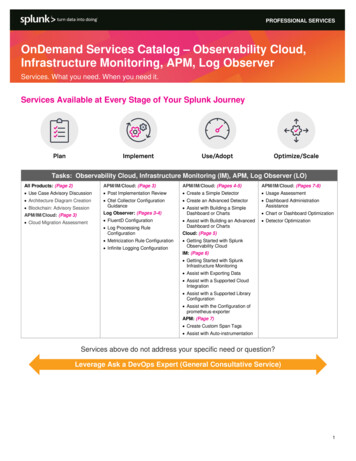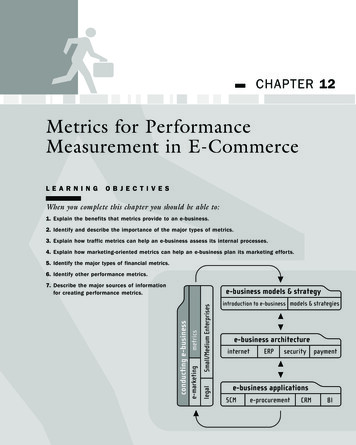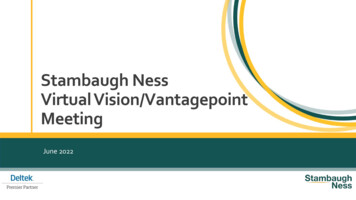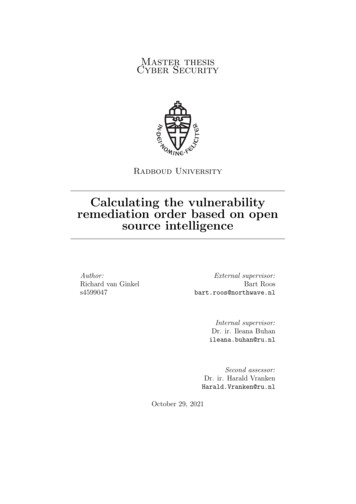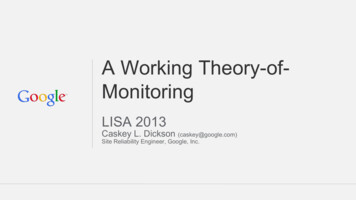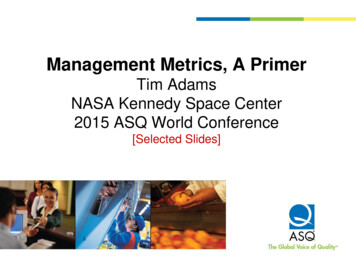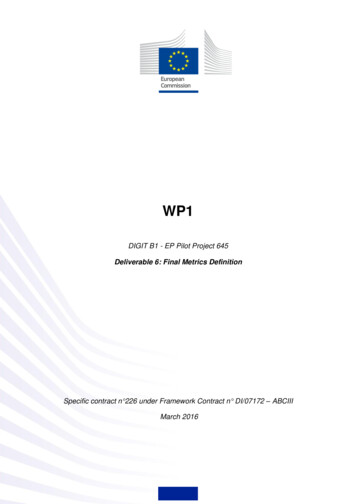
Transcription
WP1DIGIT B1 - EP Pilot Project 645Deliverable 6: Final Metrics DefinitionSpecific contract n 226 under Framework Contract n DI/07172 – ABCIIIMarch 2016
DIGIT Fossa WP1 – Governance and Quality of Software Code – Auditing of Free and Open SourceSoftware.Deliverable 6: Final Metrics DefinitionAuthor: XYZDisclaimerThe information and views set out in this publication are those of the author(s) and do not necessarilyreflect the official opinion of the Commission. The content, conclusions and recommendations set out inthis publication are elaborated in the specific context of the EU – FOSSA project.The Commission does not guarantee the accuracy of the data included in this study. All representations,warranties, undertakings and guarantees relating to the report are excluded, particularly concerning – butnot limited to – the qualities of the assessed projects and products. Neither the Commission nor any personacting on the Commission’s behalf may be held responsible for the use that may be made of theinformation contained herein. European Union, 2016.Reuse is authorised, without prejudice to the rights of the Commission and of the author(s), provided thatthe source of the publication is acknowledged. The reuse policy of the European Commission isimplemented by a Decision of 12 December 2011.Document elaborated in the specific context of the EU – FOSSA project.Reuse or reproduction authorised without prejudice to the Commission’s or the authors’ rights. Page 2 of 53
DIGIT Fossa WP1 – Governance and Quality of Software Code – Auditing of Free and Open SourceSoftware.Deliverable 6: Final Metrics DefinitionContentsLIST OF TABLES . 4LIST OF FIGURES . 5ACRONYMS AND ABBREVIATIONS . 61.2.INTRODUCTION . 71.1.OBJECTIVE OF THIS DOCUMENT AND INTENDED AUDIENCE . 71.2.DOCUMENT STRUCTURE . 71.3.KEY SUCCESS FACTORS . 71.4.DELIVERABLES . 7METRICS TO ANALYSE THE SUSTAINABILITY OF FOSS PROJECTS . 82.1.IDENTIFICATION AND ANALYSIS OF THE COMPLETE SET OF ASPECTS THAT CAN AFFECT THESUSTAINABILITY OF THE FOSS PROJECTS . 83.4.2.2.DESIGN OF A SET OF METRICS . 112.3.DEFINE METRICS CRITERIA . 122.3.1.COMMUNITY ACTIVITY . 132.3.2.PERFORMANCE . 232.3.3.QUALITY AND SECURITY . 262.3.4.DEMOGRAPHICS AND DIVERSITY . 332.3.5.GOVERNANCE . 382.3.6.FOSS SUPPORT . 44METRICS MEASUREMENT APPROACH . 473.1.TOOL TO MEASURE THE METRICS. 473.2.FREQUENCY OF THE MEASUREMENT . 473.3.RESPONSIBLE FOR THE MEASUREMENT . 473.4.RESULTS. 48BIBLIOGRAPHICAL REFERENCES . 53Document elaborated in the specific context of the EU – FOSSA project.Reuse or reproduction authorised without prejudice to the Commission’s or the authors’ rights. Page 3 of 53
DIGIT Fossa WP1 – Governance and Quality of Software Code – Auditing of Free and Open SourceSoftware.Deliverable 6: Final Metrics DefinitionList of tablesTable 1: Categories with their corresponding metrics .11Document elaborated in the specific context of the EU – FOSSA project.Reuse or reproduction authorised without prejudice to the Commission’s or the authors’ rights. Page 4 of 53
DIGIT Fossa WP1 – Governance and Quality of Software Code – Auditing of Free and Open SourceSoftware.Deliverable 6: Final Metrics DefinitionList of FiguresFigure 1: Activity .48Figure 2: Performance .49Figure 3. Quality and Security .49Figure 4: Governance .50Figure 5. Demographics and Diversity .50Figure 6. FOSS Support .51Figure 7. Comparison of Projects and Categories .51Figure 8. Average of All Categories that Indicates Overall Sustainability of Analysed Projects .52Document elaborated in the specific context of the EU – FOSSA project.Reuse or reproduction authorised without prejudice to the Commission’s or the authors’ rights. Page 5 of 53
DIGIT Fossa WP1 – Governance and Quality of Software Code – Auditing of Free and Open SourceSoftware.Deliverable 6: Final Metrics DefinitionAcronyms and abbreviationsEUIEuropean InstitutionsECEuropean CommissionEPEuropean ParliamentDGDirectorate GeneralFOSSFree and Open Source SoftwareFOSSAFree and Open Source Software AuditingOSOperating SystemSDLCSystem Development Life CycleWPWork PackageDocument elaborated in the specific context of the EU – FOSSA project.Reuse or reproduction authorised without prejudice to the Commission’s or the authors’ rights. Page 6 of 53
DIGIT Fossa WP1 – Governance and Quality of Software Code – Auditing of Free and Open SourceSoftware.Deliverable 6: Final Metrics Definition1. Introduction1.1. Objective of this Document and Intended AudienceThis document represents the deliverable 6 included within TASK-04: Final metrics definition.The objectives of this document are: To identify and categorise the aspects that can affect the sustainability of FOSS projects; To provide a list of the most relevant metrics that can be used to evaluate the sustainability of FOSSprojects; To provide a tool to measure these metrics.This document is addressed to the DIGIT areas interested in the use of these metrics to evaluate thesustainability of FOSS projects.1.2. Document StructureThis document consists of the following sections: Section 1: Introduction, which describes the objectives of this deliverable and the intended audience,the structure of the document and the key success factors. Section 2: Metrics to analyse the sustainability of FOSS projects, which identifies and describesthe metrics and respective categories that can be used to evaluate the sustainability of these projects. Section 3: Metric Measurement Approach, which describes the process for measuring the metrics.1.3. Key Success FactorsAll the steps described in Section 2 – Metrics to analyse the sustainability of FOSS projects, will ensure thefulfilment of the key success factors related to this deliverable: FOSSA outcomes provide new tools for CISO to measure the risk level of open sourcecomponents.1.4. Deliverables1Deliverable 4: Analysis of Software Development Methodologies Used in FOSS communitiesDocument elaborated in the specific context of the EU – FOSSA project.Reuse or reproduction authorised without prejudice to the Commission’s or the authors’ rights. Page 7 of 53
DIGIT Fossa WP1 – Governance and Quality of Software Code – Auditing of Free and Open SourceSoftware.Deliverable 6: Final Metrics Definition2. Metrics to Analyse the Sustainability of FOSSProjectsIf you are going to rely on a FOSS community contribution-based project for your own project, you want toensure that the community will continue to support it throughout the lifecycle of your project. For any FOSSproject, the sustainability of its communities is fundamental for its long term success.There are many different aspects of a FOSS project that can affect the community sustainability: Goodproject management, an effective structure of governance, fair licensing, leadership, community activityand performance, and support from external entities are key for healthy and sustainable FOSScommunities.In this section, we will identify the aspects that can affect the sustainability of FOSS projects, and we willdesign a set of measurable metrics that can be used to evaluate the sustainability of these projects2.1. Identification and Analysis of the Complete Set of Aspects that CanAffect the Sustainability of the FOSS ProjectsIn order to identify and analyse the complete set of aspects that can affect the sustainability of theFOSS projects, we researched and gathered information from several sources:1Everis FOSS expert team2The websites of the communities that were analysed in Deliverable 43Relevant websites and research papers (see Section 4. Bibliographical References)The information gathered was analysed and, as a result, we defined six categories of metrics, asfollows:1.Community ActivityThe overall activity of the community and how it evolves over time is a useful metric categoryfor all open source communities.The Community Activity provides a first view into how much the community is doing, and it canbe used to track the different activities that the community conducts, such as:1. How many people took part in a relevant amount of a particular activity, like codedevelopment, code review, bug fixing?2. Number of commits, releases, tickets3. Communications activity (Mailing list, posts, forums, chat history)Document elaborated in the specific context of the EU – FOSSA project.Reuse or reproduction authorised without prejudice to the Commission’s or the authors’ rights. Page 8 of 53
DIGIT Fossa WP1 – Governance and Quality of Software Code – Auditing of Free and Open SourceSoftware.Deliverable 6: Final Metrics Definition4. Number of adoptions/implementations by external organisations / communities5. Software evolution in terms of code, architecture and bug resolution, which is an indicator ofthe maturity of the project2.PerformancePerformance allows you to analyse how processes and people are completing their tasks. Forexample, you can measure:1. How long processes take to finish, like implementing a new feature, fixing a bug, orconducting code review.2. The time that it takes to resolve or close tickets3. The time spent conducting code review3.Quality and SecurityQuality and security are two very important factors to evaluate for the sustainability of a project,for two main reasons:1. A methodology that checks the quality of the code and ensures that different types of testingare conducted, which will also help the project to be of greater interest to the communities.2. A project that has included security from the design stage, and implements it throughout itslifecycle, has a much better chance to live longer, because the identified security risks willbe mitigated.4.Demographics and DiversityDemographics give us an overview of the developers and users around a project, and thecompanies that engage in it. This includes hosting and support providers, consultancy andcustomisation services, and companies that integrate the software with other products as partof solutions.The number of companies involved in a project is an important indicator, since such companieswill clearly have a strong interest in the sustainability of the software.A sustainable project accumulates partners and providers of increasing specialisation.Likewise, if there are signs of service companies moving away from supporting the project thismay be an indicator of underlying problems. As a result, projects that have been in productionfor a long time have a better chance to stay in the long run.Another factor to take into consideration is the existing knowledge in the external market,regarding the language and platforms used in the project. This factor is extremely importantbecause a project based on a very specific piece of knowledge that is not easily found or not ofDocument elaborated in the specific context of the EU – FOSSA project.Reuse or reproduction authorised without prejudice to the Commission’s or the authors’ rights. Page 9 of 53
DIGIT Fossa WP1 – Governance and Quality of Software Code – Auditing of Free and Open SourceSoftware.Deliverable 6: Final Metrics Definitioninterest to the outside community of developers may find it difficult to stay in the long term,therefore directly affecting the sustainability of the project as a whole.Diversity is an important factor in the resilience of communities. In general, the more diversecommunities are—in terms of people or organisations that participate—the more resilient theyare. For example, when a company decides to leave a FOSS community, the potentialproblems that the departure may cause are much smaller if its employees were contributing 5%of the work rather than 85%.For the organisations that support the project, it is quite useful to look at their diversity inseveral ways:1. Do they operate only in one country, or are they geographically spread out? And if so, indifferent continents?2. Are they a mix of small and large companies?3. Do they target a single sector or multiple industry sectors?5.GovernanceGovernance is essential for the sustainability and evolution of a FOSS project and itsassociated communities.It gives information on:1. How the project is organised2. Who is who in the project3. If a roadmap exists4. How well documented the project is5. The licensing structure6.FOSS SupportSupport, either financial, tangible assets or workforce, is needed to ensure the sustainability ofthe FOSS project and its associated communities. This support can take various forms:1 Financial2 Infrastructure assets3 Human ResourcesDocument elaborated in the specific context of the EU – FOSSA project.Reuse or reproduction authorised without prejudice to the Commission’s or the authors’ rights. Page 10 of 53
DIGIT Fossa WP1 – Governance and Quality of Software Code – Auditing of Free and Open SourceSoftware.Deliverable 6: Final Metrics Definition2.2. Design of a Set Of MetricsThe objective of this task is to define a set of metrics with detailed aspects that will make it easy tomeasure the sustainability of the FOSS projects.After the information gathering and the analysis conducted in task 2.1 Identification and analysis of thecomplete set of aspects that can affect the sustainability of FOSS projects, a total of 34 metrics weredefined and grouped in the six categories identified. Table 1 shows the categories with their correspondingmetrics.Table 1: Categories with their corresponding metricsCategoryCommunityActivityPerformanceQuality andSecurityNo.Metric Name1Code Activity (contributions and contributors)2Release History3Number of Commits4Number of Tickets5Communications (Mailing list, posts, forums, chat history)6Number of Adoptions/Implementations by External Organisations / Communities7SW Evolution (code, architecture, bug/feature)8Programming Language Used9Project Domain (OS, Application SW, IDE, Application servers, Libraries, desktopEnvironments and frameworks). I.e. Apache, Linux, Eclipse, Mozilla, Ant,GNoME, KDE)10Source Code (repositories like CVS/SVN for code base, GitHub, source forge).11Time to Resolve Tickets12Time Spent in Code Reviews13Pending Work14Security Requirements15Threat Modelling16Security Code reviews17Security Testing18Vulnerability Management19Software Development Methodologies20SLADocument elaborated in the specific context of the EU – FOSSA project.Reuse or reproduction authorised without prejudice to the Commission’s or the authors’ rights. Page 11 of 53
DIGIT Fossa WP1 – Governance and Quality of Software Code – Auditing of Free and Open SourceSoftware.Deliverable 6: Final Metrics DefinitionCategoryNo.Metric NameDemographics21Longevityand22Real Knowledge Existent in the market of the language and Platforms Used.23People Participating24Organisation Participating25Geographically distributed user community26Project Management27Project Roadmap28Project ding - Monetary33Work force34Infrastructure assetsDiversityGovernanceFOSS Support2.3. Define Metrics CriteriaIn order to design the forms that will be used to compile all the information for each metric, we defined thefollowing criteria:1.Metric Name: Descriptive name of the metric.2.Description: what the metric should accomplish.3.Unit of Measurement: it refers to the way the metric will be measured: a number, a maturity level,etc.4.Method: it defines how the metric will be measured.5.Measurement: it defines the actual measurement of the metric, i.e. the maturity level.6.Result: the formula applied to measure the metric.All the information of each metric is documented in the following forms, grouped in one of the 6 categoriesdefined in Task 2.1 Identification and analysis the complete set of aspects that can affect the sustainabilityof FOSS projectsDocument elaborated in the specific context of the EU – FOSSA project.Reuse or reproduction authorised without prejudice to the Commission’s or the authors’ rights. Page 12 of 53
DIGIT Fossa WP1 – Governance and Quality of Software Code – Auditing of Free and Open SourceSoftware.Deliverable 6: Final Metrics Definition2.3.1. Community ActivityM1DescriptionMetric NameCode Activity (contributions and contributors)For a project to be sustainable it must have contributors, and its codebase needs to beevolving.One can track this by looking at the project’s revision control system and looking at thepattern of contributions.This metric measures the amount of committers that contribute to a majority of thecommits in the project.Unit ofRatio of contributorsMeasurementMethodThis analysis will be carried out by checking the community website and wiki. Theinformation to look for will be the pattern of contributions, to identify the number ofcontributors who submitted 80% of the total contributions in a specific period of time(mostActiveContributors80).Formula to calculate the ratio of ors80 (mostActiveContributors80 1%xtotalContributors))(totalContributors/ totalContributors 10)Measurement1.Very split: Ratio value within the upper 20% of the maximum ratio2.Split: Ratio value ranked between 79% and 60% of the maximum ratio3.Average: Ratio value ranked between 59% and 40% of the maximum ratio4.Dependant: Ratio value ranked between 39% and 21% of the maximum ratio5.Very dependant: Ratio value within the lowest 20% of the maximum ratioDocument elaborated in the specific context of the EU – FOSSA project.Reuse or reproduction authorised without prejudice to the Commission’s or the authors’ rights. Page 13 of 53/x
DIGIT Fossa WP1 – Governance and Quality of Software Code – Auditing of Free and Open SourceSoftware.Deliverable 6: Final Metrics DefinitionM2DescriptionMetric NameRelease HistoryThis metric measures the approach followed for releases that provide information onthe update frequency1. Regular releases (disruption in the cycle might indicate sustainability or governanceissues, in which case the best way to find out is to go into the projectcommunications area and see if there is an issue)2. Releases on a “need to have" basis. Some projects make releases as and whenthey feel ready, so they do not follow an established frequency.3. When do releases occur? On the weekends (suggesting a hobby) or during theweek (suggesting a business)?Unit ofRelease frequencyMeasurementMethodLook at the release pattern for a certain period of timeMeasurement1Optimised: formal approach, regular releases are planned and deliveredperiodically, with the exception of security fixes.2Managed: informal approach, release is published when development objectivesare achieved.3Initial: informal approach, release is published without clear definition criteria.Document elaborated in the specific context of the EU – FOSSA project.Reuse or reproduction authorised without prejudice to the Commission’s or the authors’ rights. Page 14 of 53
DIGIT Fossa WP1 – Governance and Quality of Software Code – Auditing of Free and Open SourceSoftware.Deliverable 6: Final Metrics DefinitionM3DescriptionMetric NameNumber Of CommitsThe number of commits gives a general idea about the volume of the developmenteffort.Unit ofNumber of commitsMeasurementMethodThis analysis will be carried out by checking the community website and wiki. Theinformation to look for will be the number of code commits done by contributors during last year. The number of most active contributors will be those that submitted 50% ofthe total contributionsFormula to calculate the ratio:CommitsRatio itHubRepository) *100Measurement1Very active: Ratio value within the upper 51% of the maximum ratio2Active: Ratio value ranked between 26% and 50% of the maximum ratio3Average: Ratio value ranked between 6% and 25% of the maximum ratio4Inactive: Ratio value ranked between 1% and 5% of the maximum ratio5Very Inactive: Ratio value within the lowest 1% of the maximum ratioDocument elaborated in the specific context of the EU – FOSSA project.Reuse or reproduction authorised without prejudice to the Commission’s or the authors’ rights. Page 15 of 53/
DIGIT Fossa WP1 – Governance and Quality of Software Code – Auditing of Free and Open SourceSoftware.Deliverable 6: Final Metrics DefinitionM4DescriptionMetric NameNumber Of TicketsThe number of tickets opened provides information about how many bugs are reportedor the new functionalities that are proposed.Unit ofRatio of tickets createdMeasurementMethodThis analysis will be carried out by checking the community's main tasks or ticketrepository. The information to look for will be when the tickets are createdMeasurement1Very active: there are, at least, 10 tickets created in the last week.2Active: there are, at least, 10 tickets created in the last two weeks.3.Average: there are, at least, 10 tickets created in the last month.4Inactive: there are, at least, 10 tickets created in the last three months.5Very Inactive: rest of the valuesDocument elaborated in the specific context of the EU – FOSSA project.Reuse or reproduction authorised without prejudice to the Commission’s or the authors’ rights. Page 16 of 53
DIGIT Fossa WP1 – Governance and Quality of Software Code – Auditing of Free and Open SourceSoftware.Deliverable 6: Final Metrics DefinitionM5DescriptionMetric NameCommunications (Mailing list, posts, forums, chat history)The number of messages in mailing lists or posts in forums gives an idea of how manydiscussions are being held in public. However, this metric needs to differentiate thetypes of activities that are conducted in the communications, which can range fromsome serious discussions to unnecessary flame wars (in this case, the communicationchannel should not be accounted for).Unit ofNumber of active communication channelsMeasurementMethodThis analysis will be carried out by checking official communication channels providedby the community. The information to look for will be the number of activecommunication channels used by the community.Measurement1Optimised: More than three communication channels are used (different mailinglists, IRC, wiki, user forums and web post are used for the project).2Managed: At least three communication channels are used in the project.3Initial: less than three channels are used for exchanging information.Document elaborated in the specific context of the EU – FOSSA project.Reuse or reproduction authorised without prejudice to the Commission’s or the authors’ rights. Page 17 of 53
DIGIT Fossa WP1 – Governance and Quality of Software Code – Auditing of Free and Open SourceSoftware.Deliverable 6: Final Metrics DefinitionM6Metric anisations / CommunitiesDescriptionSoftware downloads provide information about the global interest in the projectEach distribution platform provides its own metrics to describe popularity. For example,on GitHub, watchers, stars, and forks are the strongest indicators of a project’spopularity and use. On WordPress.org, you can see the number of downloads a pluginreceives, as well as its average user rating. If distributed via package manager (e.g.,Rubygems, NPM), you can see the number of installs. These indicators show howmuch the project is used.Unit ofInterest levelMeasurementMethodThis analysis will be carried out by checking distribution platforms.The information to look for will be the identification and measurement of the interest, inorder to rank it within the levels defined. This level of interest will be measured bymeans of doing the following assessment:Taking the 5 most downloaded/popular projects, an average will be assessed (Av). Thelevel of popularity (using the Alexa ranking) of the project or the number of downloads(P) will be divided by that average. The result is the adoptions ratio (Ra).Ra P / AvMeasurement1Very Interesting: The ratio value is larger than 12Interesting: The ratio value is between 1 and 0,513Normal The ratio value is between 0,50 and 0,264Disappointing: The ratio value is between 0,25 and 0,115Very disappointing: The ratio value is smaller than 0,10Document elaborated in the specific context of the EU – FOSSA project.Reuse or reproduction authorised without prejudice to the Commission’s or the authors’ rights. Page 18 of 53
DIGIT Fossa WP1 – Governance and Quality of Software Code – Auditing of Free and Open SourceSoftware.Deliverable 6: Final Metrics DefinitionM7DescriptionUnit ofMetric NameSW Evolution (code, architecture, bug/feature)This metric evaluates the evolution level of the software development cycle:1Code development follows a methodology2Improvements were made to the architecture supporting the software development3Improvements were made to the bug fixing processMaturity levelMeasurementMethodThis analysis will be carried out by checking the community website and wiki.The information to look for will be the project's development lifecycle and theevaluation of these three parameters:1 Code development follows a methodology2 Architecture Improvements3 Improvements bug fixing processMeasurement1Optimised: The community applies all three parameters2Addressed: They accomplish two of the three parameters analysed3Partially Addressed: They accomplish one of the parameters4Initial: They don't address any of the parameters analysedDocument elaborated in the specific context of the EU – FOSSA project.Reuse or reproduction authorised without prejudice to the Commission’s or the authors’ rights. Page 19 of 53
DIGIT Fossa WP1 – Governance and Quality of Software Code – Auditing of Free and Open SourceSoftware.Deliverable 6: Final Metrics DefinitionM8Metric NameProgramming Language UsedDescriptionThis metric evaluates the use of a stable and widely used programming languageUnit ofUse of the programming languageMeasurementMethodThis analysis will be carried out by checking the community website and wiki.The goal is to measure the maturity of the programming language used using TIOBEIndex as indicator.http://www.tiobe.com/tiobe indexMeasurement1Very popular: First 5 entries from TIOBE2Popular: Languages ranked from 6 to 15 from TIOBE3Average: Languages ranked from 16 to 20 from TIOBE4Unusual: Rest of the languages from TIOBEDocument elaborated in the specific context of the EU – FOSSA project.Reuse or reproduction authorised without prejudice to the Commission’s or the authors’ rights. Page 20 of 53
DIGIT Fossa WP1 – Governance and Quality of Software Code – Auditing of Free and Open SourceSoftware.Deliverable 6: Final Metrics DefinitionM9Metric NameProject Domain (OS, Application SW, IDE, Applicationservers, Libraries, desktop Environments and frameworks.I.e. Apache, Linux, Eclipse, Mo
DIGIT Fossa WP1 - Governance and Quality of Software Code - Auditing of Free and Open Source Software. Deliverable 6: Final Metrics Definition Document elaborated in the specific context of the EU - FOSSA project. Reuse or reproduction authorised without prejudice to the Commission's or the authors' rights .Page 5 of 53 List of Figures
